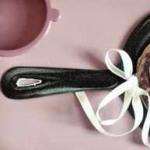Military equipment made from salt dough. The best DIY dough crafts
Dough modeling is a fun way to spend time with children. After all, they not only sculpt, but also cook: they can experiment with the flour mixture in the process of measuring and mixing ingredients, and then observe the metamorphoses that occur with the finished product when temperatures change during the drying process.
In addition, crafts made from salt dough are harmless to children, they do not contain allergens and can be safely tasted.

Figures made from homemade flour mixture are harder and preserve better than plasticine.
Basic play dough recipe
Before making modeling dough, you need to imagine what kind of products will be made, whether the dough needs to be painted, how long the modeling will take, and what drying mode will be chosen.

The basic recipe for craft dough consists of one part salt and two parts wheat flour to which 2 tsp citric acid is added. for 1 cup salt and 1 tbsp. l. vegetable oil. The amount of water added during kneading should be equal to the amount of salt.

Dough preparation method
The dough is prepared in the following order:
- Mix flour with salt and citric acid and pour this mixture into a saucepan;
- Place the pan over moderate heat and gradually add water, stirring constantly, until the dough comes away from the pan and can be rolled into a ball.
- Remove from heat and knead the dough with your hands.

Food coloring or gouache must be diluted in water, which is added before kneading the dough.

During operation, depending on the required consistency, the salt-flour mixture can be further diluted with water or oil, or flour can be added for hardness.

It is better to prepare the dough in small portions if possible, right before starting to model, and store it only in a tightly closed container or cling film.

Drying salt dough crafts
In order for handmade salt dough crafts to retain their shape and not break or crack, you need to select correct mode drying. You can simply leave the figures to dry naturally in the air, or you can place them in the oven.
There are two for oven drying different methods. The first is to preheat the oven, then turn it off and place the figures in the heated space. You can also bake the products at 100 degrees, making sure that there is no burning.

A master class on making dough crafts involves, first of all, experimenting with the material: the composition of the dough and its drying mode, so failures in this process are inevitable.
Helpful advice: When starting sculpting with children, you need to set them up so that the first success, after many not entirely aesthetic attempts, becomes a real miracle for them.

It is better to start with simple and uniform shapes, such as round beads of various colors and sizes. You can use them to make garlands to decorate your room.

Then you can master more complex silhouettes - stars, hearts, and volumetric figures – New Year's snowflakes, Christmas trees, Easter eggs with patterns, egg cups, chickens.

You can time the production of figurines to coincide with the holidays, or choose more neutral motifs for all occasions, making souvenirs and gifts in the form of stylized horseshoes, suns, stars, airplanes and funny faces.

During modeling, you can use special molds for modeling and baking, and other things, according to the prompting of your imagination: garlic crush - for making thin ropes from dough, bottle caps - for cutting out circles, plastic toy parts - for making prints, almost everything Whatever you have on hand, from toothpicks to toy car wheels, can become a tool for modeling dough.
Note!


It is easy to make holes in the salt dough, both decorative and for hanging on threads. Holes on flat figures retain their shape when dry.

But when making more voluminous parts, such as spherical balls, in order to create a hole for the thread, you need to pierce the figure with a toothpick or other sharp instrument made of wood or plastic and do not remove it until the product dries.

Helpful advice: To glue the dough elements, just wet the individual areas and apply them to each other.

You can make garlands, keychains, medals and pendants from voluminous and flat figures. You can fashion chests and cups for storing jewelry, small treasures and pencils.

Volumetric figurines of animals
Three-dimensional figurines of animals are especially popular among children; they can be made in accordance with popular step by step instructions, which are intended for plasticine and clay crafts.
Note!


You can sculpt from dough without dyes, then paint the finished figurine and, after drying, coat it with varnish.

You can also cut out various figures: having made a model of them from cardboard, place it on a smooth dough previously rolled out with a rolling pin and carefully cut out along the edges. Then you can paint the figurine, add the necessary texture - roughness, strokes, make eyes, a nose or decorations from beads.

A wonderful homemade gift could be a photo frame or a unique candlestick.

Making panels that combine elements of mosaic, applique and modeling can captivate both children and adults. For the little ones, simple drawings are suitable: you first need to draw a silhouette on parchment, then carefully fill it with dough along the lines.

You can also conceive and implement more complex ideas using beads, mosaics of cereals, dried flowers, etc.
Note!


Photos of dough crafts



















The origins of dough modeling go back a long way. There is a legend that it was invented by Slavic cooks who were bored and had fun by creating interesting, edible figures from dough. In addition, this material is one of the cheapest and available to everyone. That’s why this type of creativity is popular in our time; everyone has flour, water and salt in their home. So, a few interesting crafts made from salt dough with your own hands, with photos and step-by-step instructions.
Crafts made from salt dough
If you decide to touch this art, and testoplasty really is such, you need to learn in detail about the material from which you will sculpt. For beginners who like to make dough, it is worth noting that the recipe is very simple.
- Flour - one glass
- Salt - half a glass
- Water – 125 ml
It is worth remembering that salt is heavier than flour, so you need to use half as much of it!
To sculpt thin relief figures, you need to add PVA glue, or starch, or wallpaper glue to the dough. Optionally, one tablespoon at a time, pre-mix wallpaper glue with water. To make the kneading process easier, use a mixer; it will make it better and make it easier to work with your hands.
For modeling from colored dough, food coloring is used; if there is none, you can use regular paint. If you want a rich chocolate color, add a small amount of cocoa. Remember that when the dough dries, it loses its color saturation. Therefore, it is better to transfer the dye than not to transfer it. Coating the finished dough craft with varnish will make it brighter and more practical.
Advantages
- It is one of the cheapest and environmentally friendly materials.
- Doesn't get your hands dirty (although this is a relative statement)
- It is easy to work with, very flexible and allows you to make parts of any complexity.
"Piglet"
Let's look at the easiest way to sculpt.
To work you need:
- Salty dough
- Brush
- Stack
- Paints
- Toothpicks
How to do it
- Roll the dough into a ball and give it an oval shape, this will be the body of the pig.
- Make a second ball (head) and place it on the body using a toothpick.
- Make a small heel for the pig, a flattened ball with holes, you can make holes with the back of a pencil.
- Making ears is also not difficult; moisten the triangles with water and carefully attach them to the head.
- Do the legs like this, roll two sausages, make a small cut at one end, attach the legs to the body with the other end.
- Our piglet will sit in a basin, to do this, roll out a ball of dough and give it the appearance of a basin.
- Place the piglet in a basin and paint your craft.
- Let your masterpiece dry.
Master class on how to make a pig from dough step by step video instructions
Little secrets
Everyone has a garlic squeezer in their house. It can be used in work by passing the dough through it to obtain long curls. They can be used in the form of hair, wool for your crafts. Having a tea sieve at home will produce thinner vermicelli, for finer details of the craft.
A comb can also be used when sculpting; it will perfectly imprint a ribbed pattern on it.
"Candlestick"
Ingredients
- puff pastry
- eggs (for brushing)
- prunes
- chocolate
Cooking method
- Roll out the dough on the table. The thickness should not exceed 0.5 cm. Using a glass, cut out circles.
- Place in the middle of the prepared circles
filling. It can be prunes, dried apricots, jam, the main thing is that the filling is not liquid. - From each circle we form a star (gathering it up like a bag)
- Cut the edges with pastry scissors. And we bend each strip, turning them to the center.
- We form a flower and coat it with egg.
- Bake in the oven at 180 degrees.
- Decorating our flowers. You can put a little jam in the middle.
- We take a flat dish and, using melted chocolate, draw a stem and leaves for our delicious craft. We distribute the finished flowers in the right places on the plate and everything is ours. unusual flower ready.
"Delicious squirrel"
To prepare this craft you need to take:

Alina Rudenko
Modeling from salt dough (for children of the middle group)
What you need for work:
Glue, modeling board or working cardboard, colored cardboard (blue or blue), stacks, a little cotton wool for decorating the craft, a cap from a large diameter felt-tip pen and a soldier’s star for making an impression, scissors.

I glued stars to bottle caps to make them easy for the kids to use.
Salt dough recipe:
1 tbsp. fine salt
1 tbsp. flour
1 tbsp. spoon of vegetable oil
0.5 tbsp. water
Modeling sequence:

You need to divide the dough into 3 parts. Most part for wheels. The middle one is the tank turret. The smallest part is the cannon.

We take the largest part, make a sausage and place it in the middle of the board. Then flatten it.


Take a medium-sized piece of dough and, using circular movements, turn it into a ball, then into an “egg.”


Place it in the middle and flatten it.

Take the smallest part (for the cannon) and roll the sausage with straight hand movements.

We attach the cannon to the turret of our tank. Then we take the stack and cut off the excess, giving the cannon a smooth edge.

Our tank is almost ready, all that remains is to decorate it with a star and make wheels.





Now we need to put our craft in a warm place (possibly on a radiator). It should dry in 4-5 days. Then you can start designing it. The finished tank needs to be glued with Moment glue onto colored cardboard.

A gift for dad is ready!

And we are also ready for the holiday!
My students at work.





All the guys sculpted with pleasure and tried to make beautiful craft as a gift to dad.
Until today, designers have created many models of tanks, and during the Great Patriotic War there weren't many of them. But these heavy weapons, produced by the Soviet people in the rear, became a guarantee Great Victory. The T-72B tank model is the main combat vehicle of 1941-1945. In this lesson we will try to make a copy of the tank. And it’s fashionable to time a creative lesson to coincide with Victory Day. Of course, the easiest way is to sculpt a figure without any special features - the tank should have a massive body, a small turret on top with a barrel, and also its unique method of movement - these are massive, thundering caterpillars. But still, the details can be selected in such a way that the end result is a more or less similar copy.
To sculpt a tank of the chosen format, prepare:
Green plasticine - and you can completely limit yourself to this color;
Additionally red for the flag;
2 matches;
A toothpick.
How to make a T-72B tank from plasticine
Exactly green color makes any military object invisible, so all equipment is painted in this shade (or spotted camouflage), and the soldiers’ uniforms are also made in such camouflage colors. Make a part that resembles a matchbox in shape and size - this will be the body of the tank. Glue a strip about 1 cm wide and 0.5 cm high to the bottom of the part. It is better to round the corners to make the shape more streamlined.

Tracks are a very important chassis of a tank, and our chosen model is no exception. To make a massive structure (measured by the center piece), make six cylinders for each side. From the side, press each cylinder with a stack in the center and around the circumference several times. Pull out two more ribbons and press down with the flat side of a toothpick.

Glue the six prepared wheels on one side of the body, then press down along the entire length with ribbed tape. And also make absolutely the same caterpillar structure with a track on the opposite side.

When the main part of the tank is ready, stick green tape on top of the tracks. Make a tower of an unusual shape - round, flat, with notches around the circumference. Stick a soft mass onto the match to create a barrel.

Glue small parts on top of the tower, a cover through which the crew will get in and out of the vehicle. Make small green squares - they will play the role of armor protection in the future. There is no need to imagine here - look at the technical characteristics in the drawing, and then create similar parts.

Completely assemble the T-72B. Press down the tower on top. Glue the armor fragments on the sides. Add bolsters on top, lanterns, hooks, and grilles in front. And the most important attribute of the copied combat vehicle can be considered the Red Banner. Make a flag from a red cake and glue it to a match. Next, insert the match into the body.


The tank is ready. This craft can be done in preparation for May 9th. Surely the boys will be delighted with this idea. At the Victory Parade we will see many modern units, including aircraft. This model can be considered rather classic. This is a great keepsake for a veteran or beloved grandfather.



Elena Nikolaeva
Сhudesenka.ru
0 82 825
Modeling is one of the most useful activities for babies. With its help, not only develops fine motor skills hands, but also develops perseverance, imaginative thinking and coordination of movements.
One of the best materials for sculpting with your child - salty dough. It is absolutely safe, does not contain harmful additives and is easy to use. DIY salt dough crafts will become wonderful souvenirs for your relatives and friends.
Universal recipes
You can find a great variety of salt dough recipes. Each master adds his own additives to them, selecting the desired consistency. The main products for kneading dough are salt, flour and water.Depending on its purpose, its thickness may vary:
- dense dough - for large parts and creating massive panels;
- universal dough of medium consistency - it is convenient to make small pictures and figures from it;
- soft dough - tender and pliable, it is suitable for small elements, exquisite flowers and figurines.
Thick dough
To work you will need:- wheat flour - 1 part;
- table salt - 1 part;
- water - 0.7 parts.
That is, to knead this type of dough you need to take one identical measure (glass, cup, tablespoon) of salt and flour and 0.7 of the same measure of water.
Combine the dry ingredients in a deep bowl and add cold water little by little. The dough should be homogeneous and very dense. There will be grains of salt in it - this is normal, don't worry. Depending on the humidity and quality of flour and salt, you may need a little more or less water. Therefore, you can’t pour it into the dough all at once.
Medium consistency dough (all-purpose)
To work you will need:- wheat flour - 1 part;
- water - 1 part;
- table salt - ½ part;
- finely ground salt (extra) - ½ part.
Soft dough
To work you will need:- wheat flour - 1 part;
- hot water - 1/4 part;
- finely ground salt (extra) - 1 part;
- PVA glue - ¾ parts.
This dough is ideal for complex work. It holds its shape perfectly, preserving the prints and texture created on it. Its quality directly depends on the quality of the chosen glue.
The figures made from salt dough with glue differ special strength. They will delight their owner for many years.
- If you plan to color finished products, it is better to use wheat flour, although you can also use rye flour for salt dough.
- You cannot use iodized salt - the finished figures may crack when drying.
- The dough can be tinted while kneading. For this, food coloring or watercolors are used.
- The finished dough must be wrapped in cling film or a plastic bag to prevent it from drying out.
- A failed dough can be revived. If the dough is too liquid, you need to add a little more flour and knead again; if the dough is too tight, moisten it with water and knead, achieving the desired consistency.
- Do not add fat or hand cream to the dough from which you plan to paint the products - the paint will apply unevenly.
- The finished dough should be stored in the refrigerator for no more than 2 days. It loses its qualities and it will be inconvenient to work with it.
- It is best to sculpt volumetric products on wire or cardboard frames so that they do not fall apart.
- Crafts can be dried naturally, leaving them for a couple of days, baked in a warm oven, or left next to the radiator. It is strictly not recommended to place figurines on the battery itself to avoid cracking.
- It is best to paint crafts with acrylic paint or gouache. Watercolors should not be used: there is a risk of getting wet and ruining the product.
- The junction of the parts must be moistened with water using a brush. This way they will connect firmly and quickly.
- The finished souvenir can be coated with clear nail polish or acrylic varnish. This will protect it from moisture and the paint from fading.
Cute hedgehog - toy for kids
Do you want to know what you can make with your child using salt dough? Start with the most simple crafts. The younger your baby, the simpler the products should be. joint creativity. Try to make a prickly hedgehog, and detailed description process in this MK guarantees excellent result And good mood from a useful activity.
First of all, prepare universal salt dough and nail scissors. Roll a piece of dough into a drop-shaped piece.

The hedgehog's eyes and nose can be made from beads, black peppercorns, or pre-colored dough.

The needles are made using cuts. Use the tips of the scissors to make small cuts, lifting the needles up.

Perform the next row in a checkerboard pattern - with an offset. Row by row, make cuts until the entire back of the hedgehog is covered with needles.

Dry the finished toy in the oven or simply in a warm and dry room. If you wish, you can color it or entrust this important task to your child.

Original souvenir - funny dachshund
You can start preparing for the future ahead of time. New Year's holidays and make a funny dachshund as a gift for friends.
To work you will need:
- universal salt dough (see recipe above);
- cardboard, pencil, scissors;
- paints and brush;
- a piece of rope;
- clear nail polish;
- toothpick;
- foam sponge;
- glue "Dragon".
Transfer the template to a piece of cardboard and cut it.

Roll out the dough to approximately 5mm thickness on baking paper. Attach the template and cut out the outline of the dachshund along it. Carefully remove the trimmings so as not to deform the workpiece.

Roll two balls and form them into oblong dachshund eyes. Glue them with a drop of water to the head of the workpiece. Moisten all sections of the dog with water and smooth it with your fingers to remove all irregularities.

Use two small pieces of dough to make eyelids and glue them above the eyes. Use a toothpick to outline the ear, paws, mouth, nose and body contours.

Now you need to add volume to the workpiece. Roll the dough into an oval, glue it onto the ear and smooth the joint with a wet finger.

Add volume to the dachshund's back and tail in the same way.

Use a toothpick to press oblong dents around the perimeter of the figure. Do them randomly different lengths from the edges of the body to the center.

It's time to dry the workpiece in a warm oven. Bake it until it is completely firm.
The dry figurine needs to be painted. Cover all areas where there are bulges and dents with black gouache.

After the first coat of paint has dried, paint the dachshund yellow. Put some paint on foam sponge and tint the entire body, while the dents should remain black - do not overdo it.

Draw the eyes of the dried dachshund in white. Make any inscription you wish.

Glue a piece of rope to the back of the craft.

Cover the product with clear varnish and let it dry. The result of the work done is impressive - the mischievous puppy is ready.

Dog with original coloring:


Spectacular fish - step-by-step master class
Try making a beautiful fish with your child. Just follow detailed instructions- and even a little helper will be able to master this modeling technique.
To work you will need:
- universal salt dough;
- brush;
- corrugated felt-tip pen cap;
- ruler.

Pinch the dough on one side of the circle with two fingers, forming a tail.

Correct it and smooth out any rough edges.

On the opposite side, make a mouth for the fish using the handle of a brush.


Use the edge of a ruler or the blunt side of a knife to press the marks on the tail and fins.

Roll small balls and glue them onto the fish's head. These will be the eyes.

Make pupils from smaller balls and press them onto the eyes with the handle of a brush.


It's time to decorate the blank. Use the cap of a felt-tip pen to press down the first row of scales.

Roll a lot of small balls. Glue them with a drop of water to the body of the fish immediately behind the cap imprints and flatten them with the back of the brush.


If there is a suitable imprint, make imprints in the form starfish, no - make do with an already familiar cap or take a different template.

Then push two more rows of cap impressions.

Roll into a thin sausage to form a tail.

Glue it to the blank on the edge of the tail. Fill the entire tail in the same way.

Next, chaotically stick and push a few more small balls.
Dry the resulting workpiece in a warm oven.

Color the fish, guided by your ideas of beauty and the colors available. If you glue a magnet to the back of it, it will proudly take its place on the refrigerator, decorating the kitchen of its happy owner.

Here are some more ideas with fish:








Cheerful boletus mushroom
The initial stage of learning to sculpt is already behind us - you can begin to make more complex products from universal salt dough. Try to master the lesson of making a funny big-eyed boletus. Such an interesting mushroom will be appreciated not only by children, but also by adults.
To work you will need:
- universal salt dough;
- burnt out light bulb (classic pear-shaped);
- cardboard;
- acrylic paint or gouache;
- foil;
- paper napkins;
- masking tape;
- Super glue.

Cut a ring out of cardboard and put it on a light bulb - this is the basis of the future mushroom cap.

From the crumpled paper napkins form a hat of the desired size. Secure the structure with tape.


The result is something like this.

Wrap the hat in foil for added strength.


For the hat you can use dough of any color; later the whole toy will be painted. Roll out a piece of dough into a circle at least 3 mm thick and stick around the top of the mushroom cap.

Remove the hat and seal the bottom.

Use the blunt side of a knife to press the strips.

Secure the cap to the mushroom stem using superglue or Moment. It should be slightly tilted towards the back.

Get started with the design. Blind and attach the arms, legs and nose to the fungus.




You can decorate the figurine with a funny caterpillar or make another decorative element, such as a ladybug.

Dry the finished piece.

Paint the figurine, draw eyes and a nose and varnish. The amazing fungus is ready. You won’t be able to pickle it and eat it, but you can easily decorate a shelf with it.

Funny pig pendants
Such funny pendants are an unusual idea Christmas decorations or a cute souvenir for people dear to you.
To work you will need:
- universal salt dough;
- toothpick;
- thin rope;
- paints and brush;
- foam sponge;
- black gel pen;
- Super glue.






